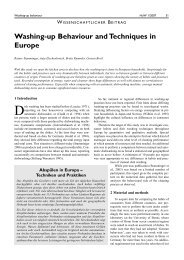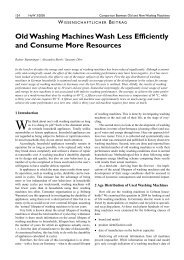Development of a novel mechatronic system for mechanical weed ...
Development of a novel mechatronic system for mechanical weed ...
Development of a novel mechatronic system for mechanical weed ...
You also want an ePaper? Increase the reach of your titles
YUMPU automatically turns print PDFs into web optimized ePapers that Google loves.
Materials and methods<br />
environments (Waurzyniak 2000). If necessary, virtual prototypes can be<br />
transferred across different plat<strong>for</strong>ms <strong>for</strong> further design modifications, when<br />
some special influences are <strong>of</strong> crucial importance (e.g. environment is not solid<br />
but fluid etc.).<br />
A final possibility with the virtual prototyping approach is the creation <strong>of</strong> a mock–<br />
up. In contrast to a prototype, which is usually functional and represents the<br />
latest version <strong>of</strong> a design, a mock–up is normally set up early in the design<br />
process when design ideas have not yet been solidified (Holub 2007). It is <strong>of</strong>ten<br />
either <strong>for</strong> a purely functional purpose with no aesthetics taken into account, or<br />
the opposite, where only the external appearance is created and no functionality<br />
is made available. The advantage is that a mock–up can be created quickly to<br />
give an early preview <strong>of</strong> a design, be<strong>for</strong>e it has been developed very far. Virtual<br />
prototyping allows very quick design <strong>of</strong> a mock–up, as a simulation assembly<br />
with very little functionality, including the prototype within its environment. This<br />
assembly can then be used to show what a model will look like without having<br />
to waste time defining the motion constrains required <strong>for</strong> movement. In this way,<br />
the functionality, speed and usefulness <strong>of</strong> a mock–up development are easily<br />
duplicated.<br />
4.2.2.1 Pro/Engineer as a s<strong>of</strong>tware tool<br />
In the past, even when parts and models were drawn in three-dimensions using<br />
s<strong>of</strong>tware such as AutoCAD, per<strong>for</strong>ming any sort <strong>of</strong> kinematical or dynamic test<br />
required a copy <strong>of</strong> the original to be completely redrawn and redefined in<br />
another s<strong>of</strong>tware application. This was because the above mentioned<br />
simulation capabilities were simply not present in drawing s<strong>of</strong>tware packages.<br />
However, several s<strong>of</strong>tware packages have recently begun to <strong>of</strong>fer all in one<br />
solutions. For example PTC’s Pro/ENGINEER (Pro/E), has the built in<br />
capabilities <strong>of</strong> Pro/MECHANICA, which is a linear Finite Element Analysis<br />
package, since the Wildfire 2.0 release. This integration allows utilisation <strong>of</strong> the<br />
same s<strong>of</strong>tware tool <strong>for</strong> both the design and simulation, making possible building,<br />
testing, and analysing <strong>of</strong> a virtual prototype in parallel. With full CAD/CAM/CAE<br />
45





